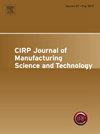The influence of magnetic field controlled electrical discharge milling on the surface quality of grooves
IF 4.6
2区 工程技术
Q2 ENGINEERING, MANUFACTURING
CIRP Journal of Manufacturing Science and Technology
Pub Date : 2025-03-25
DOI:10.1016/j.cirpj.2025.03.006
引用次数: 0
Abstract
In electrical discharge machining (EDM), the concentration of discharge debris in the machining gap will affect the discharge stability, thereby determining the surface quality of the machining. As a commonly used special machining method, discharge milling often encounters the problem of residual debris in the discharge gap during the machining process, resulting in poor machining results. In order to improve the machining efficiency and surface quality of discharge milling, this study proposes magnetic field control for discharge milling. Firstly, establish a discharge milling model and discuss the changes in the flow direction and speed of the working fluid in the bottom gap and around the electrode caused by changes in the flushing direction, while keeping the electrode feed direction unchanged. And it is stipulated that the flushing direction is the same as the electrode feed direction (same direction flushing machining), and the flushing direction is the reverse as the electrode feed direction (reverse direction flushing machining). The simulation found that there is a phenomenon of Flow around circular cylinder (FACC) around the electrode, which has adverse effects on machining. By changing the flushing direction, flushing speed, and magnetic field strength, the number of debris trapped in the machining gap was compared. The results showed that reverse flushing machining is more conducive to the discharge of debris from the machining gap, and increasing the flushing speed and magnetic field strength can accelerate the discharge of debris in the machining gap. Subsequently, a verification experiment was conducted, and the experimental results showed that compared with the same direction flushing machining, the material removal rate of the reverse direction flushing machining increased from 0.93 μg/s to 2.42 μg/s, an increase of 160.22 %. The surface roughness decreased from 4.79 µm to 2.91 µm, a decrease of 39.25 %. After applying a 200mT Halbach array magnetic field control, the material removal rate increased from 2.8 μg/s to 3.67 μg/s, an increase of 31.07 %. The surface roughness decreased from 2.58 µm to 2.21 µm, a decrease of 14.34 %.
磁场控制电火花铣削对沟槽表面质量的影响
在电火花加工(EDM)中,加工间隙中放电碎屑的浓度会影响放电稳定性,从而决定加工的表面质量。放电铣削作为一种常用的特殊加工方法,在加工过程中经常会遇到放电间隙残留碎屑的问题,导致加工效果差。为了提高放电铣削的加工效率和表面质量,提出了放电铣削的磁场控制方法。首先,建立放电铣削模型,讨论在保持电极进给方向不变的情况下,由于冲洗方向的改变导致底部间隙和电极周围工作流体的流向和速度的变化。并规定冲洗方向与电极进给方向相同(同向冲洗加工),冲洗方向与电极进给方向相反(反向冲洗加工)。仿真发现,电极周围存在绕圆柱流动现象,对加工产生不利影响。通过改变冲洗方向、冲洗速度和磁场强度,比较了加工间隙中滞留碎片的数量。结果表明:反冲洗加工更有利于加工间隙内碎屑的排出,提高冲洗速度和磁场强度可加速加工间隙内碎屑的排出;随后进行了验证实验,实验结果表明,与同向冲洗加工相比,反方向冲洗加工的材料去除率从0.93 μg/s提高到2.42 μg/s,提高了160.22%。表面粗糙度从4.79µm降低到2.91µm,降低了39.25%。施加200mT Halbach阵列磁场控制后,材料去除率由2.8 μg/s提高到3.67 μg/s,提高了31.07%。表面粗糙度从2.58µm降低到2.21µm,降低了14.34%。
本文章由计算机程序翻译,如有差异,请以英文原文为准。
求助全文
约1分钟内获得全文
求助全文
来源期刊

CIRP Journal of Manufacturing Science and Technology
Engineering-Industrial and Manufacturing Engineering
CiteScore
9.10
自引率
6.20%
发文量
166
审稿时长
63 days
期刊介绍:
The CIRP Journal of Manufacturing Science and Technology (CIRP-JMST) publishes fundamental papers on manufacturing processes, production equipment and automation, product design, manufacturing systems and production organisations up to the level of the production networks, including all the related technical, human and economic factors. Preference is given to contributions describing research results whose feasibility has been demonstrated either in a laboratory or in the industrial praxis. Case studies and review papers on specific issues in manufacturing science and technology are equally encouraged.
 求助内容:
求助内容: 应助结果提醒方式:
应助结果提醒方式:


